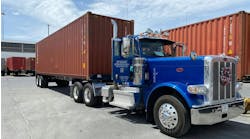Financial analysts have long realized the value of activity based costing (ABC) in uncovering the various elements driving a fleet's ability to turn a profit. The concept is simple, even for those who aren't accountants.
Although calculating an overall cost per mile (CPM) for a fleet by dividing total expenses by total miles loaded offers a general picture of an operation's cost structure, it's an imprecise tool at best, offering only intuitive hints about the real costs of specific lanes, freight or customers.
ABC starts with variable costs tied to miles driven, but then assigns fixed expenses tied to time and specific activities or circumstances. For example, variable expenses like fuel, driver mileage pay, parts, tires and tolls are measured by the mile. Fixed expenses allocated by time would include depreciation, maintenance, marketing and other costs not directly tied to miles driven. Those fixed expenses can even include such details as accessorial charges and freight density.
Combining the two types of expenses allows you to measure and forecast accurate costs for individual customers, lanes, freight, even for specific trucks and drivers. With that information in hand, a fleet can identify profitable and unprofitable operations and take steps to address those dragging down its operating ratio.
While simple in concept, ABC requires enormous amounts of accurate data to generate useful information. For the last two decades or so, the resources needed to feed ABC analysis have limited it to the major LTL carriers, and more recently, some of the largest truckload carriers, who have the information technology resources to create their own ABC models and interfaces with fleet accounting and management systems.
That barrier to ABC has now been lowered, making this accurate analysis and forecasting tool practical for fleets with as few as 50 trucks. ABC interfaces for most fleet management systems, including web-hosted systems used by small fleets, have been developed by well-established industry consulting groups like TCG (www.tcgcis.com) and Trincon Group (www.trincon.com).
The data needed to run accurate cost analysis models right down to shipment levels can now be automatically fed to ABC systems, where it can be accessed by all the various fleet mangers and executives who need it. In many cases, ABC is even integrated into so-called “dashboard” modules, making it easy to create and analyze scenarios that range from pricing a single load to determining a customer's impact on profitability.
PRIMITIVE TO SOPHISTICATED
As a mid-sized regional LTL carrier in the Mid-Atlantic and Midwest, Pitt Ohio Express has for some time used ABC on “an ad hoc basis with manual data entry into a spreadsheet to determine the profitability of new accounts or review old ones,” says Steve Milcoff, dir. of costing and analysis. “But as we grew, it was really tedious to pull all that data together, so six years ago we began looking at TCG's costing model.”
It turned out that TCG's methodology for assigning various costs matched Pitt Ohio's well. By drawing on data already in the fleet's accounting system and additional customer information maintained in a database, TCG's system “lets us [run cost analysis] on 20 to 30 accounts a day, compared to 20 to 30 a week with our manual process,” says Milcoff.
Pitt Ohio has also combined the ABC system with a business intelligence analysis tool called Cube-It. “That lets us manipulate data and run reports much more actively,” says Milcoff. “You can move data fields around, turn on or off attributes and run reports on the fly. It lets us rank thing really quickly by many variables, such as account profitability.”
In the last three years, Pitt Ohio has dropped its operating ratio by three points, and Milcoff attributes “more than half of that to ABC.”
It wasn't that ABC analysis turned up any major surprises, but rather “it quantified things we sort of expected anyway, like some bigger accounts we had questions about, and put it into numbers that showed how we were losing money on those accounts,” he says.
The benefit of determining specific performance numbers by account was that “it gave us the courage to act on things we thought were problems,” says Milcoff. “About a year and a half ago we started acting on [the ABC analysis], looking at which rates and customers made sense and which didn't.”
Initially Pitt Ohio used the data primarily for pricing, but it now translates that information into an account-by-account profitability system for the entire organization. “We even have an interface that lets employees look at accounts and — based on color coding — quickly see their activity level and value to us,” says Milcoff. The fleet also has an operations research group that's now using the ABC data to look at ways to take costs out of that part of the organization.
“Going forward, we intend to leverage the data to take costs out of all our systems, so (ABC) is not just about raising rates,” Milcoff adds.
The fleet has also started collecting vehicle location and stop data from its wireless PeopleNet communications system. “We want to compare real-world data with our costing data to see if we can fine-tune the costing models,” says Milcoff.
TRUCKLOAD ABCS
While large LTL fleets have used ABC for many years, extending the tool to truckload operations has proved more difficult, perhaps because TL managers face more varied operating conditions that might seem to make determining standardized fixed costs difficult.
“Truckload carriers have been slow to adopt [ABC] because there's the perception that CPM is the whole picture,” says Ken Manning, president of TCG and a member of the industry committee credited with creating ABC 25 years ago. “It's easy to add up loaded miles and divide by expenses. And that would work, as long as you don't have trailer pools and all your lanes are perfectly balanced. Going beyond CPM to individual load costing seems tough, though, because there are so many variables with each load moved. You do need voluminous files to get to the level of detail we get (with ABC).”
With 500 tractors and 1,300 trailers in truckload operations, deBoer Transportation Inc. of Blenker, WI, has long been recognized as an innovative fleet. Founded by Ron deBoer in 1979, it was one of the first small TL carriers to use PCs to manage its business and was an early adopter of curtain-sided trailers.
The fleet wanted to get a better handle on pricing and costs, and it knew about ABC, but “with all the variables involved in this business it didn't make sense unless we could integrate it with our fleet management system,” says Roger Placzek, vp of sales and marketing.
Last year, deBoer learned that an interface had been developed by another carrier for the TCG system and its TL-2000 program from TMW Software. By Jan. 1 of this year, the fleet began running ABC.
“Now we can look at the operating ratio and income and cost of specific lanes,” says Placzek. “It's a cultural change. We're starting to measure business on profitability rather than CPM, and we trying to drive profitability, not more miles.”
Only six months into the program, deBoer started by concentrating it analysis on its worst performing accounts. “With CPM, headhauls always look good and deadheads always look bad,” says Placzek. “But now we have a truer picture because we can see the real impact of activities. We also have credible numbers to go to customers with, and while they may not like a rate increase, now they understand it.”
In that six-month period, the fleet's operating ratio has improved by half a point. “That could just be a spike, and as we collect more data we'll get better measurements with less influence by one short good or bad period,” says Placzek. “But the important result is that with business plentiful right now and the driver shortage restricting growth, we're putting our trucks in the best business open to us.”
In some cases deBoer suspected backhauls were unprofitable, but with ABC they've discovered “they were better than we thought,” Placzek says. “I guess it was a case of needing milk to make cheese, as we say in Wisconsin.”
Not only is ABC helping the fleet to identify where it needs to raise rates, but it's also helping to monitor profitability over time. “In the past, we only had broad strokes,” Placzek says. “If a customer's revenue-per-mile was good, then we didn't look at it again. Now we can quickly rank and analyze accounts on an on-going basis. And we don't have to try to get general rate increases. Instead we can be much more selective about raising specific rates or holding them based on actual performance.”
BALANCING ACT
One major factor that gives deBoer the confidence to rely so heavily on its ABC system is that “all the data is reconciled with our general ledger,” Placzek explains. “Fixed cost assignments come directly from the general ledger into the ABC program, and all the analysis is based on those numbers. That gives our financial managers a very high degree of confidence in the data.
“We accountants see things as black or white,” says Tom Blume, CFO for Nagle Toledo Inc. “If something doesn't reconcile with the general ledger, we don't believe it's too dependable.”
Nagle is a transportation services company with brokerage and contract maintenance operations, as well as a small truckload fleet with 51 company-owned tractors and 11 owner-operators, that operates from Ohio east hauling dry and refrigerated freight. A year ago, it added Trincon's TruCosting ABC system to its Loadmaster fleet management system from McLeod Software.
That integration was important, as was Trincon's availability to complete the integration by mapping the general ledger data fields and setting expense categories. “I guess you could do it yourself, but we don't have a staff large enough to take on that kind of project,” says Blume.
With a year's worth of data in the system, Blume believes the company “is still in the teenage years of the ABC life cycle.” It's using the data to identify areas of profitability and to uncover what contributes to that profitability. “Once we see what's going on and see what prices we should be charging, we can have an intelligent discussion with our customers and justify any price increase,” he says.
The real value of ABC for Nagle will come “down the road as we develop our own benchmarks for comparison,” Blume says. “You can get [cost] data from ATA and from other fleets, but you'll never have an apples-to-apples comparison. There's nothing like having your own benchmarks to see what's changing in your business and why.”
Blume also believes that whether it's setting rates or determining profit strategies, ABC “can't replace the human element. ABC is a tool for the decision maker.”
But it's a powerful one, he adds, “and you want to use every tool you have at your disposal for success.


